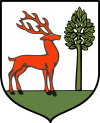Nagórzany
Nagórzany [naɡuˈʐanɨ] (Ukrainian: Нагоряни, Nahoriany), supper oppido toto Nowothanecz et suburbis – 1446, Nowothanyecz cum supperiori suburbio 1486, Wolia Przedmieszczie Nagórzany 1589, Przedmieście Nowotanieckie Górne, village in East Małopolska in the Lesser Beskid mountains, Bukowsko rural commune, parish in Nowotaniec.
Nagórzany Nagórzany | |
|---|---|
village | |
 Nagórzany | |
| Coordinates: 49°30′08″N 22°02′02″E | |
| Country | Poland |
| Beskids | Subcarpathian Voivodship |
| Founded | 1446 |
| Area | |
| • Total | 8.8 km2 (3.4 sq mi) |
| Elevation | 250 m (820 ft) |
| Population | |
| • Total | 300 |
| Time zone | UTC+1 (CET) |
| • Summer (DST) | UTC+2 (CEST) |
| Postal code | 38507 |
Nagórzany is about 10 miles from Sanok in south-west Poland. It is situated below the main watershed at the foot of the Słonne Mountain, and has an elevation of 340 metres. Situated in the Subcarpathian Voivodship (since 1999), previously in Krosno Voivodship (1975–1998) and Sanok district, (10 miles east of Sanok), located near the towns of Medzilaborce and Palota (in northeastern Slovakia). The village was a filial parish to Wola Sękowa 3 km away.
History
Nagórzany with Lipniki, Ludwikówka and Węglarzyska, village, Sanok district, it lies south of Nowotaniec, along the road to Bukowsko (3.7 km), in a hilly area 390 m. above sea level, on the divide between the Pielnica (tributary of Wisłok) and Sanoczek (tributary of the San River). Forming sort of a suburb of Nowotaniec, it carries a name in contrast to that of Nadolany, lying to the north of the town. Its population in 1880 was 446 people, ecclesiastical sematisms indicate 927 RC belonging to the Nowotaniec parish and 55 GC in the Wola Sękowa parish. The adornment of the village is the masonry cerkiew p.t. Apostles Peter and Paul, to which belong 16 mórgs of fields and 16 morgs of grubbing for fuel. Nagorzany borders with Jaworowa Wola and Bukowsko to the south. Nagórzany was founded in 1446 by Bals family.

This part of Poland was controlled by Austria for almost 120 years. At that time the area (including west and east of Subcarpathian Voivodship) was known as Galicia. In 1785 the village lands comprised 6 ½ lan. There were 50 Greek Catholics, 267 Roman Catholics and 5 Jews. In 1899 the village lands comprised 3,43 km². There were 49 Greek Catholics, 431 Roman Catholics, and 10 Jews. The church at Nagórzany is right on the road an easy to get to. Church was "Saint Michael" 1848 - Apostles Saints Peter & Paul". The name was changed from Saint Michael in 1864. The cemetery has a few headstones in it. On April 1946 the village was attacked by a strong unit of UPA and some buildings were burnt. Only over a dozen years after the war the village started to rebuild.[1] At one time the entire village was burned to the ground by the UPA with the exception of two houses belonging to Lemkos. No one was killed but every house was destroyed.
Literature
- Adam Fastnacht, Nagórzany [in:] Slownik Historyczno-Geograficzny Ziemi Sanockiej w Średniowieczu (Historic-Geographic Dictionary of the Sanok District in the Middle Ages), Kraków, (II edition 2002), ISBN 83-88385-14-3.
- Jerzy Zuba "W Gminie Bukowsko". Roksana, 2004, ISBN 83-7343-150-0. Translated by Deborah Greenlee, Arlington, TX.
References
- 3,000 in rebel band terrorized Galicia, Ukrainian Nationalists, German deserters led by SS colonel burn 3 villages (Nowotaniec, Nagórzany, and Bukowsko) in a night (by wireless to The New York Times) Sanok, Poland, April 17, 1946 – a strong, well-organized and elusive band of Ukrainian nationalists and German deserters, estimated at more than 3,000 under the leadership of a German colonel, in a fortnight have succeeded in transformating this sector of the Carpathian foothills of old Galicia into a virtual partisan stronghold. With the burning of three large villages on a single night two weeks ago, they now have made 10,000 of thise area's total pre war population of 135,000 homeless and are resisting with complete success all efforts to quell what is tantamount to open insurrection. [...] The writer of this dispatch lat week went to the heart of the bandit country, to the village of Bukowsko, where on the night of April 4 the bandits burned down all but eleven of the 400 houses and made more than 3,000 persons homeless. Our escort consisted of therefugee Mayor, now in Sanok and two squads of well-armed Security Police under the command of a nervous 20-year-old second lieutenant. Before burning the village the bandits who were well armed with German and Russian automatics and machine guns, had demanded 1,000,000 zlotys tribute, and the village had raised 300,000. On the night of the fire the villagers received scant warning a few hours before from a peasant that the bandits were coming, but had not had time to remove their cattle.
External links
| Wikimedia Commons has media related to Nagórzany. |
- Geographical Dictionary of the Kingdom of Poland and other Slavic Lands Słownik geograficzny Królestwa Polskiego i innych krajów słowiańskich. tom. XV, pages 561-562. Warszawa. 1876. (digital edition)
